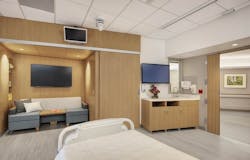Ergonomic Flooring Installation Remedy for New Neuro ICU
UW Health’s University Hospital in Madison, Wis., sought to reduce noise and improve the patient and staff experience in its newly renovated, 18-bed Neuroscience Intensive Care Unit (Neuro ICU). Installing an ergonomic healthcare-flooring product provided the solution.
Located on the fourth floor of University Hospital, the 13,000-square-foot Neuro ICU was previously a rehab unit for orthopedics. That population moved to the newly built UW Health Rehabilitation Hospital. Administrators decided more high-acuity intensive care beds were needed, and as a result, the new Neuro ICU was created. The Neuro ICU project marks the first year of a multi-year renovation to add ICU rooms.
According to Ardis Hutchins, AIA, IIDA, CHID, EDAC, a licensed architect and registered interior designer with UW Health, noise reduction to improve HCAHP scores was a high priority for the design and specification of materials for the new Neuro ICU. The selection of proper flooring was paramount to meeting that objective.
“We are a teaching research hospital, so we have many groups of people in the corridors and going into rooms, which creates added noise,” said Hutchins. “We experienced flooring failures with the old LVT product installed in the area. It delaminated over time. A complete gut and remodeling of the area was needed to increase the size of the inpatient rooms to meet the square footage requirements for an ICU.”
Comprehensive Evaluation and Testing
To make the remodeled inpatient unit a more quiet, calm, healing environment, hospital decision-makers conducted research to identify the most appropriate flooring for the Neuro ICU. Kate Bautista, LEED AP, NCIDQ, associate vice president of HGA Architects and Engineers, was selected as the lead interior designer on the project to work with the hospital facilities team.
An interdisciplinary in-house team was tasked with selecting and evaluating the new flooring standards. The team included representatives from design, environmental services, maintenance engineering, nursing, rehab, construction, and infection control.
“Making the right selection on flooring is really critical in areas that are occupied 24/7,” said Hutchins. “We were interested in Ecore’s Forest Rx product because of its acoustic properties and resilient design.”
More Ecore: Innovative Flooring Benefits
“When it comes to patient safety in the healthcare setting, acoustics and falls are among the top issues to address,” added Bautista. “Slip resistance, footfall noise and comfort underfoot then become the factors to consider when selecting flooring.”
Hutchins and the evaluating team requested and reviewed background research from Ecore on its flooring line. The team also visited and toured other Ecore Rx product installations including Mayo Hospital in Sparta, Wis., and Johns Hopkins Hospital in Baltimore, M.D.
“From a design standpoint, we always want to learn more about what other hospitals are specifying to find out if the materials have met standards and expectations,” said Hutchins.
A second phase of the assessment included extensive in-house testing of a 60-foot mockup of Ecore flooring in an unoccupied area of the hospital. The mockup was used to assess cleanability, waterjet cutting, heat welding, patching, push/pull of heavy equipment, and static load indentation recovery of both standard and bariatric beds.
“For push/pull tests, we asked staff to push weighted standard and bariatric beds, radiology equipment, ultrasound machines, and any other heavy objects that people move around,” said Hutchins. “We then asked if anyone had issues pushing the equipment on the floor and no one complained. They all thought it was acceptable.”
Cleaning crew tests included scuffing the floor, dirtying it with spills, using the scrubber machine, testing heat welds and damaging the floor to perform repairs. “The environmental services flooring supervisor reported that the Ecore surface was easy to clean and would be more cost effective for overall floor care maintenance,” said Hutchins.
The indentation recovery tests spanned two weeks and assessed the floor’s resilience under a standard bed and a bariatric bed with weights to simulate the weight of a patient. The team then photographed the indentations and tracked the time it took for the flooring to recover. “We measured the dimples in the floor and then watched as it progressively recovered,” said Hutchins.
Thematic Layouts Coming to Life: Alice in Wonderland
During the design and evaluation process, the hospital also considered feedback from patients and families. “Our hospital system really believes in the importance of including patients and families in the decision making process for all of our projects,” said Hutchins. “We met with representatives from the Patient and Family Advisory Council (PFAC) on several occasions to show them the product, present test results, and to make some design adjustments based on their aesthetic preferences.”
Flooring Installation and Results
With testing and evaluation complete, UW Health proceeded with the installation of Ecore Commercial Flooring’s Forest Rx product. Forest Rx features 5 millimeters of Ecore’s composition rubber fusion-bonded to the back of a heterogeneous vinyl layer.
The team chose the Forest Rx in oiled oak, a wood grain look for patient rooms. For a more modern look in the corridors, a combination of the Infinity Rx in honey beige and Strait Rx in sea grass was selected. “The soothing, tonal nature of the flooring acts as a timeless backdrop to the modern design,” said Bautista. “Ecore’s expanded flooring line offered us many wood grain colors and textures to choose from.” The team also specified a premium noise reducing ceiling tile as another acoustics measure to work in conjunction with the floor. The installation took place in early 2018.
With the new unit complete, UW Health is closely monitoring acoustics and falls in the updated area. “We have monitors throughout the new unit recording decibel levels to compare them to our historical benchmark readings from when the unit was previously occupied,” said Hutchins.
Future acoustic testing on a follow up phase is planned. In addition to measuring acoustics, UW Health is documenting falls on the new Ecore flooring as part of an ongoing Pebble Project research initiative.
Start Our Long-Read Series Today: Acoustics 101 for Architecture & Interiors
“I don’t think we’ve had any falls with injuries yet; but, our hope is that any injuries from falls are less severe because they are falling on a flooring surface that offers more force reduction,” said Hutchins.
Conducted by the Center for Health Design, the Pebble Project is intended to determine if the force impact reduction with flooring products results in a reduced risk of injury. Testing shows reduced force of impact compared to other flooring products. Situational research with a number of leading care providers like UW Health, will further define expected outcomes related to falls in the real-world hospital environment.
“All of the feedback we’ve gotten so far on this particular unit has been really positive,” said Hutchins. “Everyone really likes the floor with regard to comfort, and ergonomically it’s definitely less stress on people’s knees. The unit is very quiet, too, even with noisy shoes like heels.”
UW Health plans to specify more Ecore flooring throughout the hospital’s other inpatient units as they are renovated.
University Hospital is a 505-bed facility featuring a Level One adult and pediatric Trauma Center, American College of Surgeons-verified Burn Center, organ transplant programs, one of the nation's first certified comprehensive Stroke Centers, and the UW Carbone Cancer Center.
UW Health is an integrated health system at the University of Wisconsin-Madison serving more than 600,000 patients each year in the Upper Midwest and beyond. The hospital is home to approximately 1,500 physicians and 16,500 staff across six hospitals and more than 80 outpatient sites. UW Health is governed by the UW Hospitals and Clinics Authority and also partners with the UW School of Medicine and Public Health, the nation’s only combined school of medicine and public health.
About the Author

Adrian Schley
Associate Editor
Adrian Schley was an Associate Editor for i+s, where she covered the commercial interior design industry since 2018. Her work can also be found in BUILDINGS and Meetings Today.
